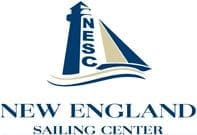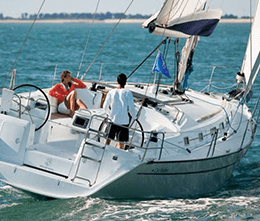Cruising can range from day sails to living aboard longer trips of several days or more, to extended sails with offshore passages.
NESC has developed a five day International Bareboat Cruising Certification (IBCC) course. The curriculum can be completed within a Monday through Friday consecutive course with live aboard format, or it can be split over weekends into a two day session and a three day session. With a three day weekend course students add in a Friday or Monday to complete their final weekend session.
Your classroom will be your cruising boat. Training will cover both theory and skill requirements for the Basic Cruising and Bareboat Cruising standards. The first two days will cover the skills for Basic Cruising with the option for ASA 103 Basic Coastal Cruising certification. The final three days will cover the skills for Bareboat Cruising with the option for ASA 104 Bareboat Cruising certification. Completion of your training will qualify you to sail a cruising yacht up to 54 feet. Testing for the ASA Basic Coastal Cruising and Bareboat Cruising certifications will provide you with International recognition of your qualifications.
We have a maximum of four students in our group courses. Private lessons are also available for individuals, couples and families.
Please visit our course and certification information page for more information on pricing. Contact us to check course availability and to schedule your course.
Directions: Getting to Us
- Prerequisites: ASA 101 Basic Keelboat certification
If certifying, students must have completed the Basic Keelboat course or have comparable training to challenge the certification.
- Certification: ASA 103 Basic Coastal Cruising and ASA 104 Bareboat Cruising certifications
Students may choose to complete the ASA 103 Basic Coastal Cruising certification exam after completing the second day’s curriculum.
Students may choose to complete the ASA 104 Bareboat Cruising certification exam after completing the fifthday’s curriculum.
Split course options:
If unable to schedule the full five days consecutively and prefer to schedule the 103 and 104 certification levels as separate course; or have previously completed the 103 level, trainees may choose from the following options:
ASA 103 2 day Day Sailor course
ASA 104 3 day Strictly Cruising course
For trainees who have previously completed the ASA 103 level, you may opt for our 3 day/2 night strictly Bareboat Cruising course to complete your 104 certification level.
Curriculum for this course includes a review of terminology and sailing techniques relative to a mid-size auxiliary cruising sailboat followed by on the water training. Topics covered include auxiliary cruising sailboat systems, maneuvering under power and sail, basic coastal navigation and coarse plotting, reefing, anchoring, crew overboard, safety at sea, radio operation, weather forecast interpretation, and heavy weather techniques.
The Basic Cruising graduate will have successfully demonstrated the ability to responsibly skipper and crew an auxiliary powered cruising sailboat, during daylight hours, within sight of land in moderate wind and sea conditions.
Recommended Equipment: It is recommended that Basic Cruising Certification courses and examinations be conducted on 23′ to 32′ sloop-rigged cruising keelboats with auxiliary power and with adequate equipment inventory to complete all required certification outcomes.
Prerequisite: The prerequisite for Basic Cruising Certification is a ASA 101 Basic Keelboat Certification.
Certification Requirements: Basic Cruising Certification requires the successful completion of the following knowledge and skill requirements. These requirements are expected to be able to be performed safely with confident command of the boat in a wind range of 5 to 15 knots. Some regions may have stronger prevailing conditions, which are acceptable if the candidate can safely control the boat, and be aware of his or her limitations in these conditions. The certified candidate will be able to skipper a keelboat up to 32′ in length.
PRACTICAL SKILLS
Preparation to Sail:
Demonstrate ability to recognize and forecast prevailing local weather conditions.
Perform an inspection of running rigging, standing rigging and hull integrity.
Check the inventory, location and operation of required safety equipment.
Check the auxiliary power systems (as applicable to your boat): location and operation of engine controls, engine mechanical and fluids check, transmission controls, ventilation system and cooling system.
Check the electrical system (as applicable to your boat): main battery switch, electrical control panel and battery terminals.
Check the bilge pump system (as applicable to your boat): operation of manual and electrical pumps, intake maintenance and bilge pump alarms.
Check the head systems (as applicable to your boat): location of controls, equipment operation, holding tanks and proper setting of valves.
Check the fresh water system (as applicable to your boat): adequate quantity, operation of manual and electrical pumps, and proper setting of valves.
Check the anchoring system (as applicable to your boat): anchors, shackles, rodes, chafing equipment and windlass.
Check all other equipment specific to your boat not indicated above.
Crew Operations and Skills:
Demonstrate winch operation and the proper procedure for clearing a fouled winch.
Demonstrate tying and use of knots: clove hitch, sheet bend and rolling hitch. Review stopper knot, bowline, cleat hitch, round turn & two half hitches and square knot.
Demonstrate how to heave a line.
Demonstrate the use of sail controls: halyards, sheets, traveler, cunningham/downhaul, outhaul, adjustable backstay (if applicable), boom vang, leech lines, jib fairleads and boom toppinglift.
Demonstrate the operation of a VHF radio: operation of controls, channel usage, call sign, weather channels and simulate an emergency call.
Demonstrate a comprehensive crew briefing and plan of responsibilities.
Leaving the Dock or Mooring:
Demonstrate appropriate helmsman and crew coordination and skills for departure under power suitable to the conditions: line handling, casting off, fending off and boathandling.
Demonstrate the use of docklines, including springlines, for boat control while departing.
Demonstrate stowing of docklines and fenders.
Boat Control in Confined Waters:
Demonstrate in close quarters under power: speed and momentum control, windage and prop walk control, and command of the crew.
Demonstrate ability to maneuver under sail in close quarters: short tacking and controlled jibes.
Demonstrate a recovery plan for an engine failure in a crowded and busy harbor.
Navigation:
Determine your position in open water, the position of your destination, your intended track and approximate travel time to that destination.
Confirm your progress along that intended track with visual observations or with visual observations and electronic confirmation. Obtain and utilize relevant tide and current information. Using a chart, verify sufficient depth for a planned cruise.
Boat Control in Open Water:
Demonstrate ability to steer a compass course with changes in course to a given destination.
Demonstrate helm and boat control in a variety of wind and sea conditions.
Heavy Weather Sailing:
Demonstrate proper reefing techniques: determining when to reef, roller furling or changing headsails, reefing the mainsail, dropping sails, shaking out a reef, and rehoisting underway.
Demonstrate helm and boat control while sailing under shortened sail.
Overboard Rescue Methods:
Properly demonstrate one of the overboard rescue methods, which is most appropriate for: your sailing ability, boat type, crew experience, wind and sea conditions, and maintaining constant visual contact with the person in water.
Safety and Emergency Procedures:
Simulate procedure and operation of VHF radio in various emergency situations.
Simulate failure of steering system, and demonstrate steering and boat control with sails.
Anchoring Techniques:
Select an anchorage, and demonstrate appropriate helmsman and crew coordination and skills for properly anchoring with a single anchor under power.
Demonstrate appropriate helmsman and crew coordination and skills for retrieving your anchor under power.
Returning to the Dock or Mooring:
Demonstrate appropriate helmsman and crew coordination and skills for arrival under power suitable to the conditions: boathandling, deploying fenders, stopping and tying up.
Demonstrate correct use and deployment of docklines, including springlines.
Securing the Boat Properly:
Demonstrate stowing of sails, rigging and equipment. Thoroughly clean the boat, and install any covers and dock power equipment.
Check both the electrical and bilge systems for dock operation.
Check the locks on companionway, lockers and hatches. Make a final check of docklines, spring lines and fender placement.
KNOWLEDGE
Crew Operations and Skills:
Describe typical crew responsibilities and communications while aboard an auxiliary powered cruising sailboat.
Explain weather recognition and forecasting techniques for a day sail.
Explain the sequence for determining blocked engine cooling system circulation.
Understand the different types and operation of stoves, and fuel systems.
Be familiar with the use of a float plan.
Understand your state and local boating regulations.
Sailing Theory:
Describe sailboat dynamics: Center of Effort, Center of Lateral Resistance, and effects and influences of lee and weather helm.
Describe real and apparent wind, and their relationship to each other.
Leaving the Dock or Mooring:
Understand the effects of wind, tide and currents in relation to the boat and surrounding area, while preparing to get underway.
Describe the differences and alternatives for leaving under power in upwind, crosswind and downwind situations.
Navigation:
Understand the organization of a Mercator chart, including: latitude and longitude, chart scales, chart symbols (Chart No.1), title block, warnings, how to determine distance and direction, and the relationship between time/speed/distance.
Understand the U.S. aids to navigations (IALA System B).
Understand the magnetic influences that may disrupt compass readings.
Understand variation and describe the use of a compass rose.
Understand Digital Selective Calling (DSC) and Maritime Mobile Service Identity (MMSI).
Navigation Rules, International & Inland:
Know the Navigation Rules, International-Inland, Rules 4 through 10 for steering and sailing.
Describe the Navigation Rules, International-Inland, for Stand-On and Give-Way sailboats and powerboats for collision avoidance and understand your state and local boating regulations.
Boat Control in Open Water:
Explain the dangers of a lee shore.
Overboard Rescue Methods:
Understand the Quick-Stop, Lifesling-type, and Figure-8 overboard rescue methods under sail to include: constant visual contact with the person in water, communications, rescue plan, sequence of maneuvers, boathandling, course sailed, pickup approach and coming alongside the person in water (or simulated object).
Describe methods of getting a person in water back on deck after the vessel is stopped alongside.
Explain when overboard recovery should be done under power and the inherent dangers.
Safety and Emergency Procedures:
Describe recovery methods after going aground.
Be familiar with firefighting equipment on board: regulations, types, location and operation.
Be familiar with the location and operation of emergency steering system and boat control during failure of the steering system.
Understand towing techniques: maneuvering onto a tow, handling and securing a towline, chafing protection, boat speed, dropping off a tow and communications.
Describe the proper function of lifelines and pulpits.
Explain proper fueling techniques and potential hazards.
Explain the purpose and use of a radar reflector.
Be familiar with the U.S. Coast Guard safety requirements for auxiliary powered vessels.
Be familiar with at least six distress or emergency signals.
Anchoring Techniques:
Explain different types of anchors and various bottom conditions suited for each type.
Explain how to determine the required scope of an anchor rode.
Describe accepted etiquette when anchoring in the vicinity of other boats.
Returning to the Dock or Mooring:
Describe the differences and alternatives for arrival under power in upwind, crosswind and downwind situations.
The Bareboat Cruising graduate will have successfully demonstrated the ability to skipper and crew an inboard auxiliary powered cruising sailboat within sight of land and bring it safely to anchor during daylight hours.
Recommended Equipment: It is recommended that Bareboat Cruising courses and examinations be conducted on 30′ to 45′ sloop-rigged cruising keelboats with wheel steering and auxiliary diesel power, and with adequate equipment inventory to complete all required certification outcomes.
Prerequisite: The prerequisite for Bareboat Cruising Certification is a ASA Basic Cruising Certification.
Certification Requirements: Bareboat Cruising Certification requires the successful completion of the following knowledge and skill requirements. These requirements are expected to be able to be performed safely with confident command of the boat with a wind of at least 15 knots.
PRACTICAL SKILLS
Preparation to Sail:
Obtain an appropriate weather forecast for your cruise and plan accordingly.
Check the sail inventory and select the appropriate sails for the conditions.
Check the location and condition or operation of all safety equipment.
Describe the need for and perform the daily checks of the engine fluids and mechanical parts, manual and electric bilge pumps, and the electrical, mechanical, fresh water, marine head and holding tank systems.
Perform a complete check and demonstrate safe use of the galley stove and stove fuel system.
Ensure that all necessary provisions, cooking and eating utensils are aboard and properly stowed.
Check the security and operation of all hatches, ports and companionways.
Inventory and check the condition of all bimini tops, cockpit awnings and dodgers where applicable.
Inventory and check the condition of all tools and spare parts.
Check the condition of dinghy and oars (and outboard, if applicable).
Inventory and check the condition of all required charts, tide tables, cruising guides and navigation tools.
Perform a complete inspection of all deck gear: standing and running rigging, lifelines, stanchions and pulpits.
Understand your responsibilities and liabilities as a bareboat charter customer according to your contract with your charter company.
Crew Operations and Skills:
Demonstrate a comprehensive crew briefing and plan of responsibilities.
Demonstrate the operation of the emergency steering equipment.
Leaving the Dock or Mooring:
Demonstrate the proper lashing of a dinghy on deck or securing it for towing.
Demonstrate appropriate helmsman and crew coordination and the skills necessary for leaving under power in any wind condition.
Navigation:
Demonstrate your ability to: correctly use a handbearing compass and a ship’s compass; maintain a proper DR plot with time/speed/distance calculations; work up an estimated position; plot a fix using lines of position and/or ranges; use depth sounder; use accepted plotting and labeling techniques; understand buoyage systems and aids to navigation; identify and correlate visual observations and landmarks with chart symbols.
Use a GPS chartplotter to plan and sail a multi-leg route.
Heavy Weather Sailing:
Demonstrate shortening sail to depower, and explain effects on balancing the boat.
Demonstrate heaving-to.
Overboard Rescue Methods:
Properly demonstrate one of the overboard rescue methods under sail, which is most appropriate for: your sailing ability, boat type, crew experience, wind and sea conditions, and maintaining constant visual contact with the person in water.
Demonstrate an overboard recovery method under power which allows you to maintain visual contact with the person in water.
Anchoring Techniques:
Select an anchorage and demonstrate appropriate helmsman and crew coordination and the skills necessary to anchor with two anchors under power using one of the following methods: bow and stern, two anchors off the bow at 60°, or two anchors off the bow at 180° (Bahamian Moor).
Pick up a mooring.
Demonstrate appropriate helmsman and crew coordination and the skills necessary to recover your anchor under power.
Returning to the Dock or Mooring:
Demonstrate appropriate helmsman and crew coordination and the skills necessary for returning to the dock under power in any wind direction.
Securing the Boat Properly:
Demonstrate the correct procedure for returning the charter boat in the same condition that it was chartered, and complete a charter check-in report on the condition of the boat.
KNOWLEDGE
Preparation to Sail:
Understand bareboat charter procedures and responsibilities for both the charter company and the charter client.
Determine the vessel’s fuel capacity, fuel consumption, and cruising range under power.
Be familiar with the documentation required for the vessel and crew both nationally and internationally.
Be familiar with the legal responsibilities of a skipper and the courtesies to be observed when entering a foreign port.
Understand the legal responsibilities of the overboard discharge of pollutants.
Understand all federal, state and local regulations as they pertain to your boat.
Be familiar with all required documentation for crew and vessel nationally and internationally.
Crew Operations and Skills:
Understand how to safely go aloft and explain the reasons for doing so.
Describe commonly observed nautical etiquette when cruising in foreign waters.
Be familiar with proper rafting techniques at docks and at anchor.
Navigation:
Understand how to: use tide and tidal current tables including secondary station predictions; use the rule of twelfths; and apply set and drift and anticipated leeway when determining a course to steer.
Understand IALA Systems A and B, including cardinal marks.
Be familiar with the considerations, responsibilities and special techniques required for navigation in restricted visibility.
Understand the meaning of the visual observations of water color.
Be familiar with the benefits and limitations of cruising guides.
Understand Automatic Identification System (AIS).
Understand the limitations and potential dangers of electronic navigation.
Heavy Weather Sailing:
Describe the signs of an approaching squall and the actions to be taken.
Describe the safety issues involved with heaving to.
Overboard Rescue Methods:
Be familiar with the equipment provided for overboard rescue.
Understand procedures for overboard recovery in a larger cruising boat in unfamiliar waters and with a crew that you might not sail with regularly. Understand the Quick-Stop, Lifesling-type and Figure-8 overboard rescue methods under sail to include: constant visual contact with the person in water, communications, recovery plan, sequence of maneuvers, boathandling, course sailed, pickup approach, and coming alongside the person in water (or simulated object).
Describe methods of getting an overboard recovery person in water back on deck after the vessel is stopped alongside.
Explain when overboard rescue should be done under power and the inherent dangers.
Safety and Emergency Procedures:
Giving due consideration to the state of the tide, describe a plan of action if you run aground in moderate conditions.
Describe a plan of action if your vessel has: a broken thru-hull; been holed; an engine failure; a steering failure.
Anchoring Techniques:
Describe the procedures for anchoring with two anchors.
Describe the use of a tripline/anchor buoy.
Describe the procedures for clearing fouled anchor rodes, and for recovering an anchor from under another boat.
Describe the procedures for dealing with a dragging anchor.
Describe the advantages and disadvantages of the following anchoring methods: bow and stern, two anchors off the bow at 60°, two anchors off the bow at 180° (Bahamian Moor), and Mediterranean moor.
Returning to the Dock or Mooring:
Describe the precautions when docking under sail.
Securing the Boat Properly:
Describe the responsibilities of the charter client and the charter company when returning the boat.



